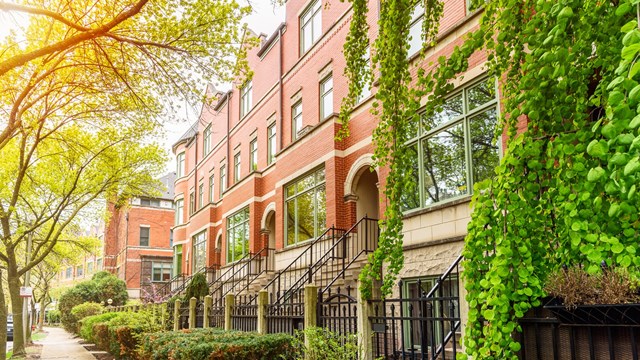Along with the exterior appearance of buildings themselves, landscaping is the first point of contact for potential residents and visitors to a condo or HOA community. While it’s tough to quantify the effect of beautifully curated and maintained exteriors on the lives of residents, the importance of physical upkeep and care is well-documented. Attractive, healthy landscaping has true value – not only in improving and maintaining quality of life and community morale, but also in terms of elevating curb appeal, and by extension, property values.
The Value of Professional Input
While worrying about flower beds when there’s a roof project looming may seem frivolous, or hiring a professional landscape architect may feel like an avoidable expense when plenty of residents have green thumbs and a burning desire to get into the dirt in the early spring—the fact is that hiring and collaborating with the right team of pros can save money and boost value. A knowledgeable plant and landscaping expert can inform and support your enthusiastic in-house gardeners, and help ensure that they’re working with good information, accurate seasonal timetables, and the proper tools.
We spoke to some multifamily landscaping professionals to find out how boards, managers, and landscaping/gardening committees can make the best choices for their building or HOA when it comes to choosing what to plant; where and when to plant it; and how best to maintain flowers, bushes, and other elements throughout the year.
Biggest Mistake
When asking any group of professionals how exactly to make things go right, it’s rare to get a unanimous response. When it comes to landscaping, however, the pros we spoke with all agreed that the biggest mistake a co-op or condo board can make is “not doing a master plan.”
That’s the word from Chapman Manzer of Manzer’s Landscape Design & Development, Inc., in Peekskill, New York. “What happens when you do piecemeal projects is it ends up looking like that: piecemeal,” Manzer says. “It looks like it wasn’t well thought out. When you do a master plan, it allows you to see what the whole will look like.”
Sherman Fields, Vice President of the Acres Group, a landscaping firm that has offices in Illinois, agrees. He adds that a master plan isn’t just figuring out where the rhododendron bush is going to go; there are administrative components to successful landscaping as well, and some of them should be in place long before the first shovel of dirt goes flying.
“That they don’t plan in advance,” Fields says. “Some boards don’t sign their contracts until the last minute, which doesn’t allow contractors and property managers to adequately plan. Most landscape [contracts] in our area begin on April 1st, and we will have people sign it close to or even on that date – but a contractor needs to put a crew together. A building is expecting a good service that we can provide, but logistically, a lot goes in on our end to make that happen.”
Manzer advises thinking in terms of “big vision versus little vision” to help avoid not just subpar aesthetics, but also unnecessary costs. “For example,” he says, “don’t fix the front of a building before you do the rear.” Work crews traipsing back and forth while toting equipment and tools to the rear of the property will invariably cause wear and tear to the front, resulting in additional – and unnecessary – costs to restore it. “Planning helps cost reduction and aesthetics, which will ultimately give everyone what they want,” says Manzer.
Fields advises always looking ahead and hiring a company that can be responsible for multiple seasons of maintenance. “A good rule of thumb is to always think a season ahead,” he says. “Come April 1st, you should really be thinking of next year’s snow – and when snow season starts, you should think about the lawn. We recommend that the same contractor be used for both seasons, and that buildings sign a snow-into-lawn contract. That way, the same company will have landscaping repair in mind when negotiating snow removal. If the snow removal company does not have the lawn contract, it can be very problematic.”
Another benefit of proper planning with a professional company is the consistency a long-term plan can provide even as many aspects of the building’s functionality are in flux. “A master plan also helps with rotating boards and leadership,” says Manzer. Fields adds that the big vision goes beyond just one season. “A lot of times, we don’t recommend a one-year plan, but instead a three- to five-year plan. A lot of times, something the board wants is just not in the budget – but three years [down the road], the money may become available.”
Then of course there’s the ground-level, plant-related wisdom that comes from years of professional experience and training, which the gentle beauty of a well-manicured lawn can belie.
“Landscaping is a lot harder than you think,” says Saira Moolchan of Staying Green, a landscaping company in Davie, Florida. “Some flowers only grow during spring or fall, while some trees don’t bloom annually and can leave only branches. Certain species need special climates, and on top of that, grass needs to be properly hydrated and treated to maintain its health. Trees need to be properly inspected to ensure that they are healthy and not obstructing roads or sidewalks. It’s almost impossible for one person to know all this, unless you hire a professional landscaper.”
Moolchan also believes the results are worth the cost. “What’s better than knowing you live in an attractive community without doing any of the manual labor?” she asks.
Education, Communication, and Transparency
Landscaping is both a professional trade and an art form – one that serves a practical and quantifiable purpose – so it’s crucial that expectations, limitations, and other logistical considerations be clearly articulated and understood on both sides of the board/professional equation. “A lot of times, the expectation is, ‘Just make it look great,’” says Fields. While that’s certainly the end goal of any landscaping project, getting there requires a bit more detail.
To help flesh out the picture of what a community may want versus what’s sensible or financially feasible, Moolchan suggests boards consider bringing examples from other communities in their area to the early planning conversations. “The HOA should benchmark itself against another community in the neighborhood that it would like to mirror in terms of curb appeal and landscaping,” she says, adding that this step helps begin the conversation from a place of reasonable expectations, since what is aesthetically pleasing in another community in the area will most likely meet the climate sustainability requirements for your building as well.
“Visit [other] properties, take photos, and share them among your board members as well as your landscaper,” suggests Moolchan, “so they can provide communication and feedback as to what they would like to have in their space and seek recommendations on the feasibility.”
Clear, open communication extends to issues of money as well. “There should be open communication between boards, contractors, and property management when working on a budget,” says Fields. “It’s the contractor’s responsibility to spend within the budget, to work to find the highest and best use of that money, and help educate the building representatives on what is feasible and reasonable within the budget constraints.”
“The competitive nature of the business often limits what the HOA may reveal to us when we are doing a proposal for them,” adds Moolchan. “But if they do let us know their budget, we will work with them to provide the options that would best meet their needs.”
This level of transparency takes a certain amount of trust when getting the relationship going. But once you find the right contractor for the job, the pros stress that it’s good to keep in mind that both you and your professional have the common goal of successful execution and maintenance.
“You have to be comfortable with whoever you’re working with, and know that they have your best interests at heart,” says Manzer, “Being in the business for 15 years, I have an idea about what things cost. There are things that are easier to maintain [than others], and it’s best to be upfront and tell building representatives. Educate them – and make sure everything is in writing.”
When working with a trusted professional, education is often part of the service provided. “As a contractor, I’m always going to provide professional information,” says Fields. “We actually give boards the horticultural encyclopedia so they know it’s not just us saying it. Every contractor should provide adequate information on plant maintenance.”
When Mistakes Happen
Any number of factors can contribute to a misplaced plant or some other landscaping element that just isn’t working. Whether it’s a shrub that’s outgrown all expectations and is now blocking the sidewalk, or a flowerbed that has become a magnet for neighborhood pet waste, the question quickly becomes what to do about it now.
“There are always going to be plenty of things to do,” says Fields. “The first job is to take care of what you have, focusing on the health and vitality of what is already in place. If something needs to be replaced, our job is to recommend replacements that would be hardy and do well, and have the longest lifespan, so to speak. We discuss any sort of ‘mistakes’ with the board, what their tolerance level is for it, and then work within the budget to make corrections as needed based on that conversation.”
Sometimes it’s the best intentions of other building professionals with less knowledge or different short-term goals that causes problems long before the landscaping professional has been brought into the conversation.
“You have to think about the long-term characteristics of the plant material before you place that plant,” says Moolchan. “A lot of builders want instant visual impact, to make the property sell faster. But a great plant in the wrong spot is going to be a waste. It will either need extensive maintenance, or outright removal and replacement.”
When working to solve these problems immediately and effectively, Moolchan brings us back around to the most important component to successful landscapes: planning. “The biggest factor in minimizing the negative impact of a sustainability mistake is proper planning,” she says. “Proper planning involves setting a budget – knowing what you can afford, and working in phases if necessary; hiring professionals who know what type of plant matter would work well in the space; and contingency planning, especially for areas prone to natural disasters like our most recent hurricane season on the southeastern coast of the U.S.”
Worth the Investment
A quick Google search can produce hard numbers attesting to the potential financial benefits of a well-planned, well-executed and well-maintained landscaping strategy – and the pros back those numbers up. According to Fields, “In terms of property value, a well-maintained landscape will provide a 15 percent better return than a poorly-maintained landscape,” but some evidence suggests buildings can expect even higher returns. Impressive as it is, that 15 percent figure doesn’t capture all of the ways in which a properly-planned sustainable landscape can improve building or association’s overall worth.
“To quantify the return on an investment in landscaping is very difficult in my opinion,” says Moolchan. “Aesthetics and curb appeal are the first impression of a home or community. And just like with making a good first impression when you meet someone, attention to details in landscaping can not only increase the value of the property, but increase the chances for a more efficient and effective marketing strategy of the property.”
Whether it’s beginning from scratch or correcting mistakes of the past, the consensus among landscaping pros is that planning is key to the success of a building’s relationship to those exterior first impressions. Combined with transparency and a little bit of education, boards can ensure a successful, budget-sound strategy is in place. Once all those factors are in place, professional care can lead to truly beautiful results.
“Arguably, the best benefit of hiring a company to do your community’s green maintenance is the ease of it all,” says Moolchan. “It means less responsibility for you and other HOA board members, so you can rest easy in your beautiful community.”
K. Valada is a freelance writer and frequent contributor to The Chicagoland Cooperator.







Leave a Comment